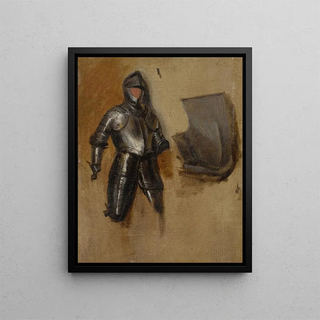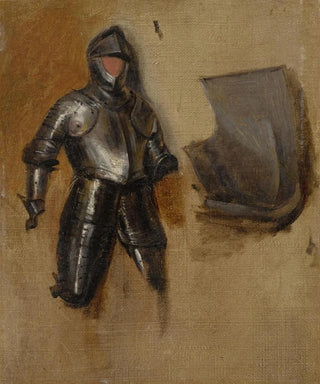Art print | Study of a half-armor from the 16th century - Richard Parkes Bonington Source: Reproduction | Étude d'une demi-armure du XVIe siècle - Richard Parkes Bonington


View from behind

Frame (optional)
In the fascinating universe of art history, certain works stand out for their ability to capture the essence of an era and evoke deep emotions. The art print Étude d'une demi-armure du XVIe siècle - Richard Parkes Bonington is a perfect example. This painting, although depicting a craft object, transcends its status to become a window into the past. By exploring the intricate details of this demi-armure, the viewer is transported to the heart of the Renaissance, a period where art and war intertwined in a delicate dance. Bonington, with his undeniable talent, manages to breathe new life into this artifact, paying homage to the skill of the artisans of his time while offering a reflection on beauty and function.
Style and uniqueness of the work
Richard Parkes Bonington's work is distinguished by its meticulous attention to detail and its ability to render textures in an almost tangible way. In this study, each brushstroke seems to tell a story, each reflection of light on the steel of the demi-armure evoking the power and majesty of 16th-century knights. The composition is carefully orchestrated, highlighting the complexity of the armor while maintaining a certain lightness. The nuances of color, ranging from metallic grays to golden sparks, illustrate not only Bonington's technical mastery but also his keen sense of aesthetics. The work does not merely depict an object; it invites the viewer to contemplate the duality of war and beauty, a recurring theme in Renaissance art.
The artist and his influence
Richard Parkes Bonington, an emblematic figure of the 19th century, is often considered a precursor to the Impressionist movement. His ability to capture light and atmosphere profoundly influenced his contemporaries and future generations. Although Bonington is primarily recognized for his landscapes and seascapes, his exploration of the demi-armure subject reflects his interest in the world around him, whether it be nature or historical artifacts. His technique, combining precision and expressiveness, paved the way to

Matte finish

View from behind

Frame (optional)
In the fascinating universe of art history, certain works stand out for their ability to capture the essence of an era and evoke deep emotions. The art print Étude d'une demi-armure du XVIe siècle - Richard Parkes Bonington is a perfect example. This painting, although depicting a craft object, transcends its status to become a window into the past. By exploring the intricate details of this demi-armure, the viewer is transported to the heart of the Renaissance, a period where art and war intertwined in a delicate dance. Bonington, with his undeniable talent, manages to breathe new life into this artifact, paying homage to the skill of the artisans of his time while offering a reflection on beauty and function.
Style and uniqueness of the work
Richard Parkes Bonington's work is distinguished by its meticulous attention to detail and its ability to render textures in an almost tangible way. In this study, each brushstroke seems to tell a story, each reflection of light on the steel of the demi-armure evoking the power and majesty of 16th-century knights. The composition is carefully orchestrated, highlighting the complexity of the armor while maintaining a certain lightness. The nuances of color, ranging from metallic grays to golden sparks, illustrate not only Bonington's technical mastery but also his keen sense of aesthetics. The work does not merely depict an object; it invites the viewer to contemplate the duality of war and beauty, a recurring theme in Renaissance art.
The artist and his influence
Richard Parkes Bonington, an emblematic figure of the 19th century, is often considered a precursor to the Impressionist movement. His ability to capture light and atmosphere profoundly influenced his contemporaries and future generations. Although Bonington is primarily recognized for his landscapes and seascapes, his exploration of the demi-armure subject reflects his interest in the world around him, whether it be nature or historical artifacts. His technique, combining precision and expressiveness, paved the way to






